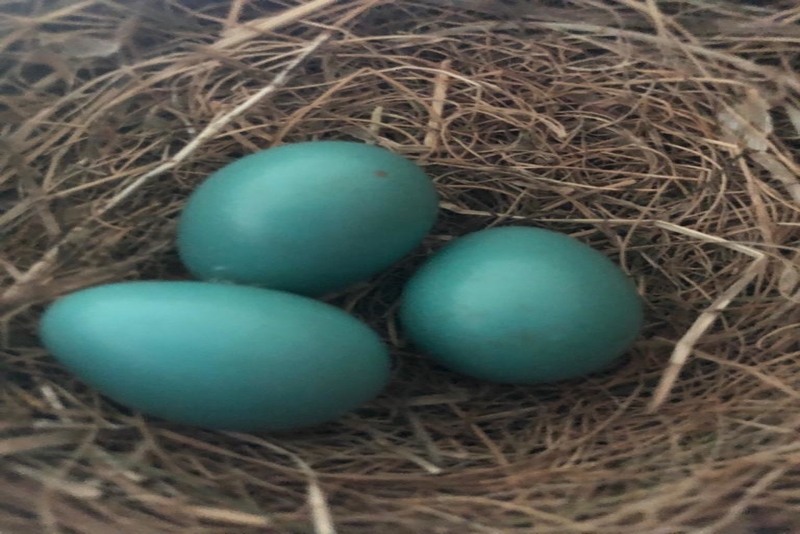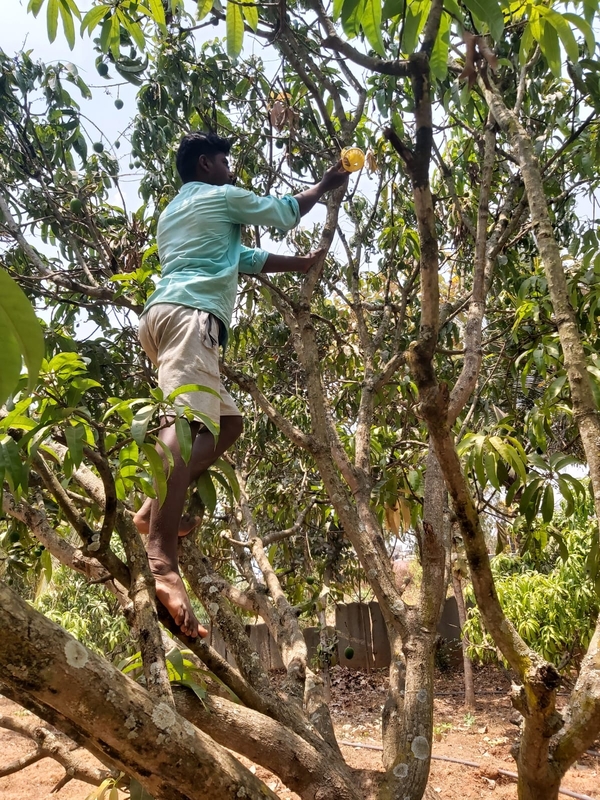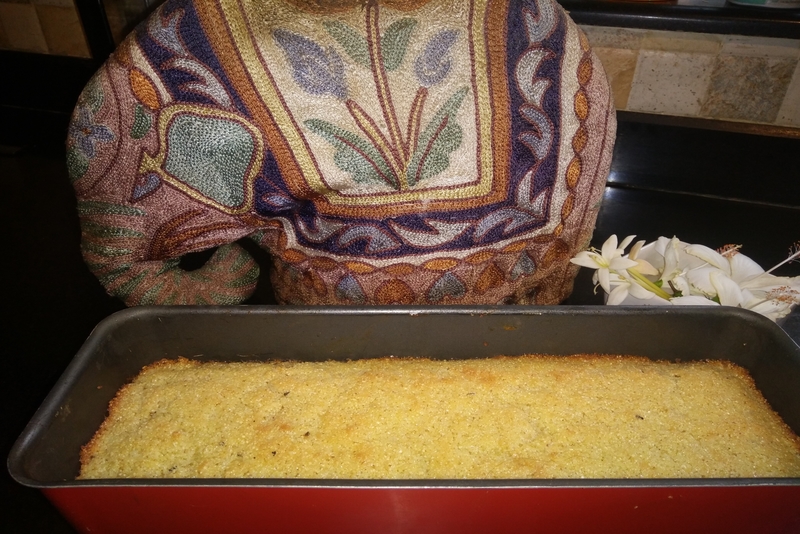Nesting time for the robins in Tennessee

Being in Tennessee for Spring is the best gift I could have given to myself. It is the nesting time for the American Robins (Turdus migratorius) besides ofcourse a burst of flowers all over the city and in gardens.
In the back yard, where the rain water pipes carry the rain water down into the back garden, a Robin has taken up residence in an old nest, which has been there ever since the kids bought the house, four years ago. Every time I go out to put down the wet waste into the compost pit, or to cook on the table out back, the robin flies off and perches on the fence, squawking irritably at me.
American robins are so much larger than the little fist sized, cute British Robin, but both are lovable and both find earth worms irresistible. Infact the American Robin is so strong, it is able to spy an earthworm in the lawn and then a tug-of war begins, exactly like the cartoons!
According to the Cornell Birds website, American Robins pair-bond during the breeding season. Females are primarily responsible for building the nest that is made of twigs, mud and lined with dry grass. Sometimes the nest will have string or ribbon that the robins find thrown out by a careless human. The robins nest may also have lichens and moss collected from trees.
The bowl-shaped nests are built in a bush, tree or under the eaves of buildings - 5 to 25 feet off the ground. The nest is 6 inches across and 4 to 6 inches high. The rounded inside area of the nest is about 3.5 to 4 inches in diameter, which is large enough to hold a baseball.
To be successful, the robin nest must last for more that a month, safely hold 4 growing birds and provide insulation from the heat and cold. From the kind of building skills I have seen the nests being reused year after year by both robins and Mourning doves, they are wonderful little architects.
Think of the nest as a baby incubator with the female robin providing the heat required for the young to develop inside the egg. The female continues to sit on the nest for 10-12 days after all the nestlings hatch. She keeps the nestlings warm, safe and dry.
As mentioned earlier, the nests are reused over the years. A second pair are refurbishing an old nest in the V of the decorative plum out front now. Not a very smart idea as it’s high enough for the neighbours cat to dive in and have a snack of a baby bird. I check on the bird once in a while and it seems to be bringing fresh material and is busily sprucing up the nest.
These nests in the crook of the rain pipe are under the eaves and well protected from wind and rain. So, if you find an old bird nest it's a good idea to leave it alone.Nest location is critical in a rainy area like Tennessee.
While my son was cleaning out the drains on top of the house, he took the picture accompanying the story. The female typically lays two to four light blue eggs - about the size and weight of a quarter. The eggs are such a pretty colour and quite unusual when first seen. The female incubates the eggs over a two-week period and both parents care for the young. The eggs take around two weeks to hatch and the chicks will fledge when they are about 12 to 14 days old. The female may produce two broods of young each year. The young are born with their eyes shut and first open their eyes around five days after hatching. At the moment the female is busy sitting on the eggs, incubating them.
Both parents aggressively defend the nest area. They emit a series of alarm calls that distract predators. When the nestlings hear the alarm call, they duck down low in the nest and remain silent so they to go undetected. When the female is sitting on the nest she is silent and moves slowly since she doesn't want predators to find the nest. During feeding, the young make chirping sounds, but these calls can only be heard a short distance away.
Watch out as Male robins are well known for dive-bombing people and predators within ten feet of a nest. The birds will swoop down close to your head to and call loudly to draw your attention away from the nest site. But these birds only make alarm calls and don’t get aggressive when we pass the nest.
The nestlings poop after every feeding, but the nest is very clean, so where does all the waste go? According to the birding site, nestlings produce a "fecal sac" - a white bundle of poop - after each feeding. After the nestling eats a worm, they lift up their rear and excrete the white sac which is collected in the beak of the adult bird. Fecal sacs are like disposable diapers for birds! Sometimes the parent carries the fecal sac away in their beak and drops it far from the nest. Other times the adult swallows the fecal sac at the nest site as apparently, the parents eat the sacs for extra nutrition.
For now I wait and watch to see when the eggs will hatch in one nest and when the eggs are laid in the second. The biggest worry is the neighbours cat, we need to arrange some deterrent to keep the fledglings safe, when they are born.
In the back yard, where the rain water pipes carry the rain water down into the back garden, a Robin has taken up residence in an old nest, which has been there ever since the kids bought the house, four years ago. Every time I go out to put down the wet waste into the compost pit, or to cook on the table out back, the robin flies off and perches on the fence, squawking irritably at me.
American robins are so much larger than the little fist sized, cute British Robin, but both are lovable and both find earth worms irresistible. Infact the American Robin is so strong, it is able to spy an earthworm in the lawn and then a tug-of war begins, exactly like the cartoons!
According to the Cornell Birds website, American Robins pair-bond during the breeding season. Females are primarily responsible for building the nest that is made of twigs, mud and lined with dry grass. Sometimes the nest will have string or ribbon that the robins find thrown out by a careless human. The robins nest may also have lichens and moss collected from trees.
The bowl-shaped nests are built in a bush, tree or under the eaves of buildings - 5 to 25 feet off the ground. The nest is 6 inches across and 4 to 6 inches high. The rounded inside area of the nest is about 3.5 to 4 inches in diameter, which is large enough to hold a baseball.
To be successful, the robin nest must last for more that a month, safely hold 4 growing birds and provide insulation from the heat and cold. From the kind of building skills I have seen the nests being reused year after year by both robins and Mourning doves, they are wonderful little architects.
Think of the nest as a baby incubator with the female robin providing the heat required for the young to develop inside the egg. The female continues to sit on the nest for 10-12 days after all the nestlings hatch. She keeps the nestlings warm, safe and dry.
As mentioned earlier, the nests are reused over the years. A second pair are refurbishing an old nest in the V of the decorative plum out front now. Not a very smart idea as it’s high enough for the neighbours cat to dive in and have a snack of a baby bird. I check on the bird once in a while and it seems to be bringing fresh material and is busily sprucing up the nest.
These nests in the crook of the rain pipe are under the eaves and well protected from wind and rain. So, if you find an old bird nest it's a good idea to leave it alone.Nest location is critical in a rainy area like Tennessee.
While my son was cleaning out the drains on top of the house, he took the picture accompanying the story. The female typically lays two to four light blue eggs - about the size and weight of a quarter. The eggs are such a pretty colour and quite unusual when first seen. The female incubates the eggs over a two-week period and both parents care for the young. The eggs take around two weeks to hatch and the chicks will fledge when they are about 12 to 14 days old. The female may produce two broods of young each year. The young are born with their eyes shut and first open their eyes around five days after hatching. At the moment the female is busy sitting on the eggs, incubating them.
Both parents aggressively defend the nest area. They emit a series of alarm calls that distract predators. When the nestlings hear the alarm call, they duck down low in the nest and remain silent so they to go undetected. When the female is sitting on the nest she is silent and moves slowly since she doesn't want predators to find the nest. During feeding, the young make chirping sounds, but these calls can only be heard a short distance away.
Watch out as Male robins are well known for dive-bombing people and predators within ten feet of a nest. The birds will swoop down close to your head to and call loudly to draw your attention away from the nest site. But these birds only make alarm calls and don’t get aggressive when we pass the nest.
The nestlings poop after every feeding, but the nest is very clean, so where does all the waste go? According to the birding site, nestlings produce a "fecal sac" - a white bundle of poop - after each feeding. After the nestling eats a worm, they lift up their rear and excrete the white sac which is collected in the beak of the adult bird. Fecal sacs are like disposable diapers for birds! Sometimes the parent carries the fecal sac away in their beak and drops it far from the nest. Other times the adult swallows the fecal sac at the nest site as apparently, the parents eat the sacs for extra nutrition.
For now I wait and watch to see when the eggs will hatch in one nest and when the eggs are laid in the second. The biggest worry is the neighbours cat, we need to arrange some deterrent to keep the fledglings safe, when they are born.

Related Articles
Editor's Picks Articles
Top Ten Articles
Previous Features
Site Map
Content copyright © 2023 by Marianne de Nazareth. All rights reserved.
This content was written by Marianne de Nazareth. If you wish to use this content in any manner, you need written permission. Contact Marianne de Nazareth for details.





 -resizeimage.jpg.jpg)

